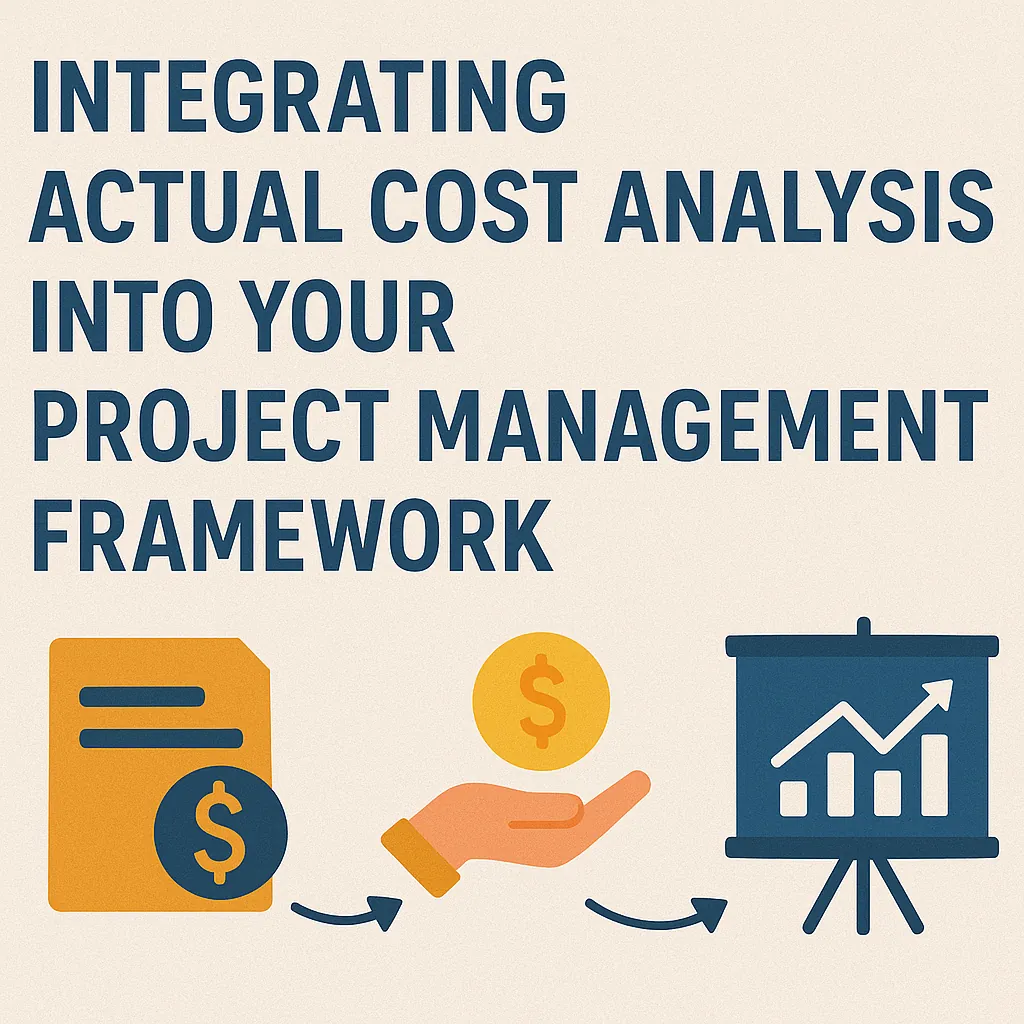Introduction to Actual Cost Analysis
Understanding and managing costs is paramount to ensuring project success. One of the critical components of effective cost management is the concept of actual cost.
Defining Actual Cost
Actual cost refers to the total expenses incurred for a project, encompassing all direct and indirect costs associated with project activities. This includes costs such as labor, materials, overhead, and any other expenditures that contribute to the completion of project tasks. The importance of actual cost in project management cannot be overstated, as it serves as a benchmark for evaluating project performance against the budgeted costs. By analyzing actual costs, project managers can identify variances, assess financial health, and make informed decisions to steer the project back on track if necessary [1][10].
The Role of Cost Management
Cost management is a systematic approach that involves planning, estimating, budgeting, and controlling costs to ensure that a project is completed within its approved budget. It plays a crucial role in successful project delivery by providing a framework for tracking financial performance and ensuring that resources are allocated effectively. Effective cost management not only helps in maintaining financial discipline but also enhances the overall project viability and profitability [2][15].
Benefits of Integrating Actual Cost Analysis
Integrating actual cost analysis into existing project management frameworks offers several advantages:
- Enhanced Decision-Making: By having a clear understanding of actual costs, project managers can make more informed decisions regarding resource allocation and project adjustments, leading to better outcomes [11].
- Improved Budgeting Accuracy: Actual cost data can inform future budgeting processes, allowing for more accurate estimates based on historical performance [10][14].
- Increased Accountability: Regularly analyzing actual costs fosters a culture of accountability among project teams, as they become more aware of their spending and its impact on project success [13].
- Risk Mitigation: Understanding actual costs helps in identifying potential financial risks early, enabling project managers to develop effective mitigation strategies [11][12].
The Importance of Actual Cost Tracking
Accurate tracking of actual costs is a cornerstone of effective project management, playing a pivotal role in ensuring project success. Here are several key points that underscore its significance:
- Critical for Project Success: Keeping a close eye on actual costs is essential for maintaining control over project budgets. Effective cost management strategies help prevent budget overruns, which can jeopardize project viability and lead to financial losses. By establishing clear cost controls and continuously monitoring expenses, project managers can ensure that projects remain on track and within budget [3][9].
- Informed Decision-Making: Actual cost data serves as a vital resource for decision-making throughout the project lifecycle. By comparing actual costs against estimated costs, project managers can identify variances and understand their implications. This analysis aids in making informed decisions regarding resource allocation, risk management, and project adjustments. For instance, variance analysis allows project managers to pinpoint the reasons for cost discrepancies and assess their impact on overall project performance [8][14].
- Resource Allocation: Tracking actual costs enables project managers to allocate resources more effectively. By understanding where funds are being spent, managers can make strategic decisions about reallocating resources to areas that require additional support or investment. This proactive approach can enhance project efficiency and ensure that critical tasks are adequately funded [4][12].
- Case Studies of Success and Failure: Numerous case studies illustrate the impact of actual cost tracking on project outcomes. For example, a construction project that implemented rigorous actual cost tracking was able to identify cost overruns early in the process, allowing the team to make necessary adjustments and ultimately complete the project within budget. Conversely, a software development project that neglected to track actual costs faced significant overruns, leading to project delays and a loss of stakeholder confidence. These examples highlight the importance of integrating actual cost analysis into project management methodologies to drive success and mitigate risks [2][6].
Common Project Management Methodologies
Various methodologies provide frameworks that guide project execution, each with its unique approach to cost management. Understanding these methodologies is crucial for integrating actual cost analysis effectively. Below is a brief overview of popular project management methodologies, how they address cost management, and their adaptability to include actual cost analysis.
1. Agile
- Overview: Agile is an iterative approach that emphasizes flexibility and customer collaboration. It is particularly popular in software development and projects requiring rapid changes.
- Cost Management: Agile methodologies, such as Scrum, focus on high-level cost estimation rather than detailed task-level budgeting. Costs are often managed through sprints, where teams estimate the effort required for each iteration.
- Adaptability for Actual Cost Analysis: Agile can incorporate actual cost analysis by integrating cost tracking tools within each sprint. This allows teams to compare estimated costs against actual expenditures, facilitating real-time adjustments and enhancing financial accountability.
2. Waterfall
- Overview: Waterfall is a linear and sequential approach where each phase must be completed before the next begins. It is often used in construction and manufacturing projects.
- Cost Management: In Waterfall, cost management is typically established during the planning phase, with detailed budgets created for each project phase. This methodology relies heavily on upfront cost estimation.
- Adaptability for Actual Cost Analysis: Waterfall can effectively integrate actual cost analysis by implementing regular financial reviews at the end of each phase. This allows project managers to assess variances between planned and actual costs, enabling better forecasting for subsequent phases.
3. PRINCE2
- Overview: PRINCE2 (PRojects IN Controlled Environments) is a structured project management method that emphasizes organization and control throughout the project lifecycle.
- Cost Management: PRINCE2 includes a dedicated focus on cost management, requiring detailed business cases that outline financial implications and budget controls at each stage.
- Adaptability for Actual Cost Analysis: PRINCE2’s structured approach makes it well-suited for actual cost analysis. By incorporating regular financial reporting and variance analysis into its governance framework, PRINCE2 can ensure that actual costs are continuously monitored and compared against the planned budget.
Strategies for Integrating Actual Cost Analysis
Integrating actual cost analysis into project management practices is essential for enhancing financial oversight and ensuring project success. Here are actionable strategies that project management professionals can implement to embed actual cost analysis within their existing methodologies:
- Establish a Framework for Regular Cost Reporting and Analysis: Create a structured approach to cost reporting that includes regular intervals for reviewing actual costs against budgeted amounts. This framework should outline the frequency of reports, the key metrics to be analyzed, and the stakeholders involved in the review process. Regular analysis helps in identifying variances early, allowing for timely corrective actions to be taken [6].
- Utilize Project Management Software Tools: Leverage technology by adopting project management software that supports actual cost tracking. These tools can automate the collection and reporting of cost data, making it easier to monitor expenditures in real-time. Features such as dashboards and alerts can provide project managers with immediate insights into cost performance, facilitating proactive management of project finances [7].
- Incorporate Actual Cost Analysis into Project Planning and Budgeting Phases: During the initial stages of project planning, integrate actual cost analysis into the budgeting process. This involves using historical data and cost estimation techniques to create more accurate budgets. By embedding actual cost considerations from the outset, project teams can set realistic financial expectations and improve the accuracy of their forecasts [10].
- Train Project Teams on the Importance and Methodology of Actual Cost Analysis: Invest in training programs that educate project teams about the significance of actual cost analysis and the methodologies involved. Understanding how to analyze actual costs, interpret variances, and apply this knowledge to decision-making is crucial for project success. Training should cover best practices in cost management and the use of relevant tools and techniques [3][5].
By implementing these strategies, project management professionals can effectively integrate actual cost analysis into their frameworks, leading to improved financial control and project outcomes. This proactive approach not only enhances the ability to manage costs but also supports informed decision-making throughout the project lifecycle.
Tools and Techniques for Actual Cost Analysis
Integrating actual cost analysis into project management frameworks is essential for ensuring projects remain within budget and for making informed decisions throughout the project lifecycle. Here are some effective tools and techniques that project management professionals can utilize to enhance their actual cost analysis.
Popular Software Tools for Tracking Actual Costs
- Microsoft Project: This widely-used project management software offers robust features for tracking actual costs. It allows project managers to input actual expenditures against planned budgets, providing a clear view of financial performance throughout the project lifecycle. The software also supports Earned Value Management (EVM), enabling users to measure project performance against cost and schedule baselines [5][11].
- Trello: While primarily a task management tool, Trello can be adapted for cost tracking through the use of power-ups and integrations. By creating cards for budget items and linking them to actual expenditures, project teams can visualize their spending in real-time. This flexibility makes Trello a popular choice for teams looking for a more agile approach to project management [4].
- Primavera: This software is particularly favored in large-scale projects, offering advanced features for cost management, including detailed cost estimation, budgeting, and tracking. Primavera’s capabilities allow for comprehensive reporting on actual costs, making it easier to identify variances and adjust project plans accordingly [4].
- Asana: Similar to Trello, Asana can be customized to track actual costs by creating tasks for budget items and linking them to actual spending. Its user-friendly interface and collaborative features make it a suitable option for teams that prioritize communication and transparency in cost management [4].
Techniques for Measuring and Reporting Actual Costs
- Earned Value Management (EVM): EVM is a powerful technique that integrates project scope, schedule, and cost to assess project performance. By comparing the planned value (PV), earned value (EV), and actual cost (AC), project managers can determine cost variances and performance indices. This method not only helps in tracking actual costs but also provides insights into project health and forecasts future performance [11][15].
- Bottom-Up Estimating: This technique involves estimating costs at the most granular level and aggregating them to form a comprehensive budget. By tracking actual costs against these detailed estimates, project managers can identify discrepancies early and make necessary adjustments [12].
- Cost Control Techniques: Implementing cost control techniques, such as variance analysis and trend analysis, allows project managers to monitor actual costs continuously. By regularly comparing actual costs to the budget, teams can identify trends and variances, enabling proactive management of project finances [5][14].
Enhancing Cost Forecasting and Risk Management with Data Analytics
Data analytics plays a crucial role in improving actual cost analysis by providing deeper insights into spending patterns and project performance. Here are some ways data analytics can enhance cost forecasting and risk management:
- Predictive Analytics: By analyzing historical data, project managers can identify patterns and trends that inform future cost estimates. Predictive models can help forecast potential overruns and enable teams to implement corrective actions before issues escalate [6].
- Risk Assessment: Data analytics can enhance risk management by identifying cost-related risks early in the project. By analyzing data from previous projects, teams can develop risk profiles and mitigation strategies tailored to specific project contexts [6].
- Real-Time Reporting: Utilizing data analytics tools allows for real-time reporting of actual costs, enabling project managers to make informed decisions quickly. This immediacy helps in adjusting project plans and resource allocations to stay within budget [6].
Challenges in Implementing Actual Cost Analysis
Integrating actual cost analysis into project management frameworks can significantly enhance decision-making and resource allocation. However, project management professionals often encounter several challenges when attempting to embed this analysis into their existing methodologies. Below are some common obstacles along with strategies to overcome them, as well as insights from experienced project managers.
Common Challenges
- Data Accuracy and Availability: Accurate data is crucial for effective actual cost analysis. In many cases, project managers struggle with gathering comprehensive and reliable data, which can lead to flawed analyses and misguided decisions. The complexity of estimating project expenses, considering various factors, adds to this challenge [6][7].
- Stakeholder Buy-In: Gaining the support of stakeholders is essential for successful implementation. However, stakeholders may be resistant to change, especially if they do not fully understand the benefits of actual cost analysis. This resistance can hinder the integration process and limit the effectiveness of the analysis [10].
- Resource Limitations: Many organizations face constraints in terms of time, budget, and personnel. These limitations can impede the ability to conduct thorough actual cost analyses and may lead to prioritizing other project management tasks over this critical analysis [11].
Strategies to Overcome Challenges
- Enhancing Data Management Practices: Implementing robust data management systems can improve the accuracy and availability of project data. Utilizing project management software that integrates real-time data tracking can help ensure that project managers have access to the most current and relevant information [6][10].
- Educating Stakeholders: Conducting workshops and training sessions can help stakeholders understand the value of actual cost analysis. By demonstrating how this analysis can lead to better decision-making and resource allocation, project managers can foster greater buy-in from stakeholders [10][12].
- Leveraging Technology: Utilizing advanced project management tools and software can help mitigate resource limitations. These tools can automate data collection and analysis processes, freeing up project managers to focus on strategic decision-making rather than manual data entry [11][12].
- Building a Culture of Continuous Improvement: Encouraging a culture that values continuous improvement can help organizations adapt to the challenges of integrating actual cost analysis. By promoting open communication and feedback, project managers can identify issues early and adjust their strategies accordingly [12][13].
Insights from Experienced Project Managers
- Navigating Resistance: Experienced project managers emphasize the importance of addressing stakeholder concerns directly. They recommend involving stakeholders early in the process and soliciting their input to create a sense of ownership over the actual cost analysis initiative [10][12].
- Focusing on Incremental Changes: Many project managers suggest starting with small, manageable changes rather than attempting a complete overhaul of existing processes. This approach allows teams to gradually adapt to new practices and build confidence in the benefits of actual cost analysis [11][13].
By recognizing these challenges and implementing effective strategies, project management professionals can successfully integrate actual cost analysis into their frameworks, ultimately leading to improved project outcomes and enhanced organizational efficiency.
Measuring the Impact of Actual Cost Analysis
Integrating actual cost analysis into project management frameworks is essential for enhancing decision-making and ensuring project success. This section will guide project managers on how to evaluate the effectiveness of this integration by focusing on key performance indicators (KPIs), methods for assessing impact, and the importance of continuous improvement.
Define Key Performance Indicators (KPIs) Related to Cost Management
Establishing clear KPIs is crucial for measuring the effectiveness of actual cost analysis. These indicators should align with the project’s financial goals and overall objectives. Some relevant KPIs include:
- Cost Variance (CV): This measures the difference between the budgeted cost of work performed and the actual cost incurred. A positive CV indicates that the project is under budget, while a negative CV signals overspending.
- Schedule Variance (SV): This assesses the difference between the planned progress and the actual progress, helping to identify any delays that may impact costs.
- Cost Performance Index (CPI): This ratio of earned value to actual costs provides insight into cost efficiency. A CPI greater than 1 indicates that the project is performing well financially.
- Return on Investment (ROI): Evaluating the financial return relative to the costs incurred helps stakeholders understand the project’s value.
By defining these KPIs, project managers can create a framework for monitoring actual costs and their implications on project performance [5][10].
Discuss Methods for Assessing the Impact on Project Outcomes and Stakeholder Satisfaction
To effectively assess the impact of actual cost analysis on project outcomes, project managers can employ several methods:
- Earned Value Management (EVM): This technique integrates project scope, schedule, and cost variables to provide a comprehensive view of project performance. By analyzing EVM metrics, managers can identify trends and variances that affect project outcomes.
- Stakeholder Surveys and Feedback: Regularly soliciting feedback from stakeholders can provide qualitative insights into how actual cost management practices influence satisfaction and project success. This can include structured surveys or informal discussions to gauge perceptions of cost management effectiveness.
- Post-Project Reviews: Conducting thorough evaluations after project completion allows teams to analyze actual costs against planned budgets and assess the overall impact on project objectives. This retrospective analysis can highlight areas for improvement in future projects.
These methods enable project managers to quantify the effects of actual cost analysis on both project outcomes and stakeholder satisfaction, ensuring that financial management aligns with broader project goals [2][9].
Encourage Continuous Improvement Through Regular Evaluation and Feedback Loops
Continuous improvement is vital for maintaining the effectiveness of actual cost analysis within project management methodologies. Project managers should establish regular evaluation cycles to review KPIs and gather feedback. This can be achieved through:
- Monthly or Quarterly Reviews: Regularly scheduled meetings to assess cost performance against established KPIs can help identify trends and areas needing attention. These reviews should involve key stakeholders to ensure a comprehensive understanding of project dynamics.
- Feedback Mechanisms: Implementing structured feedback loops allows team members and stakeholders to share insights on cost management practices. This can lead to the identification of best practices and areas for improvement.
- Training and Development: Investing in training for project teams on cost management techniques and tools can enhance their ability to analyze actual costs effectively. Continuous learning fosters a culture of improvement and adaptability.
By embedding these practices into the project management framework, organizations can ensure that actual cost analysis remains a dynamic and integral part of their project management processes, ultimately leading to better project outcomes and stakeholder satisfaction [1][6][9].
Conclusion
The integration of actual cost analysis is not merely a beneficial practice; it is essential for ensuring project viability and success. Actual cost analysis provides project managers with a clear understanding of financial performance, enabling them to make informed decisions, allocate resources effectively, and maintain control over project budgets. By embedding this analysis into existing project management methodologies, professionals can enhance their ability to monitor expenses, identify variances, and implement corrective actions promptly.
To effectively integrate actual cost analysis into your project management framework, consider the following strategies:
- Develop a Tailored Plan: Each organization has unique needs and challenges. Craft a customized plan that outlines how actual cost analysis will be incorporated into your existing processes. This plan should include specific goals, timelines, and responsibilities to ensure accountability and progress tracking.
- Leverage Technology: Utilize project management software that supports cost tracking and analysis. Many tools offer features that allow for real-time monitoring of actual costs against budgeted amounts, facilitating timely adjustments and informed decision-making.
- Train Your Team: Invest in training programs that focus on cost management and analysis. Equip your team with the necessary skills to interpret cost data effectively and apply it to project decision-making. This will foster a culture of financial awareness and accountability within your organization.
- Regularly Review and Adjust: Establish a routine for reviewing actual cost data and comparing it with project budgets. This practice will help identify trends, variances, and areas for improvement, allowing for proactive management of project finances.
For those looking to deepen their understanding of cost management, consider exploring the following resources:
- Professional Development Courses: Enroll in courses focused on project cost management, budgeting, and financial analysis. Many organizations offer certifications that can enhance your credentials and knowledge base.
- Industry Publications and Journals: Stay updated with the latest research and best practices in project management by reading industry publications. These resources often provide case studies and insights into successful cost management strategies.
- Networking Opportunities: Join professional organizations or forums where project management professionals share experiences and strategies related to cost management. Engaging with peers can provide valuable insights and support.
By prioritizing actual cost analysis within your project management practices, you can significantly improve your project’s financial outcomes and overall success. Take the next steps today to integrate these strategies into your framework, and watch as your project management capabilities evolve to meet the demands of an increasingly complex business environment.
Find out more about Shaun Stoltz https://www.shaunstoltz.com/about/.
This post was written by an AI and reviewed/edited by a human.



